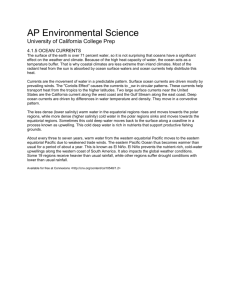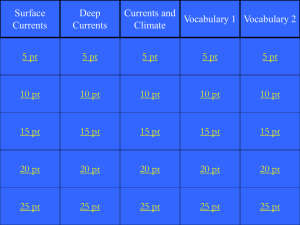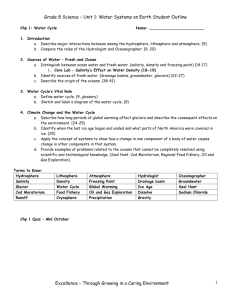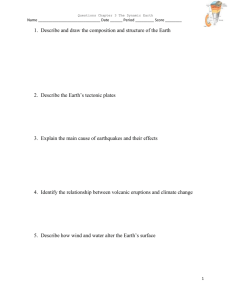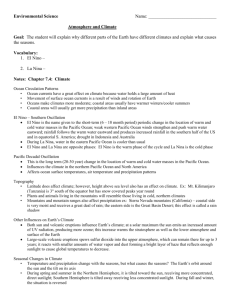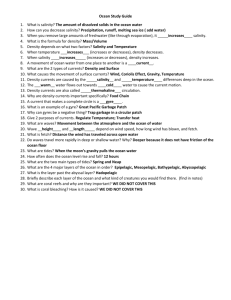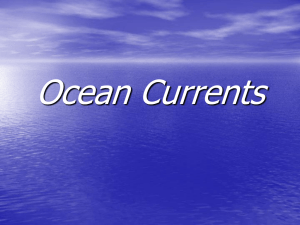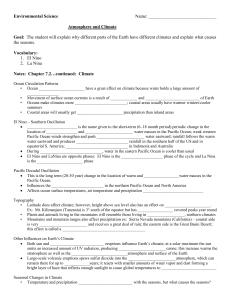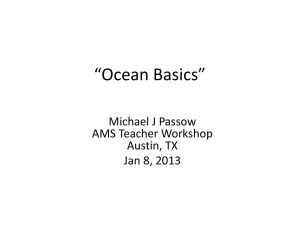Oceanography Notes Oceanography is the study of the ocean using
advertisement
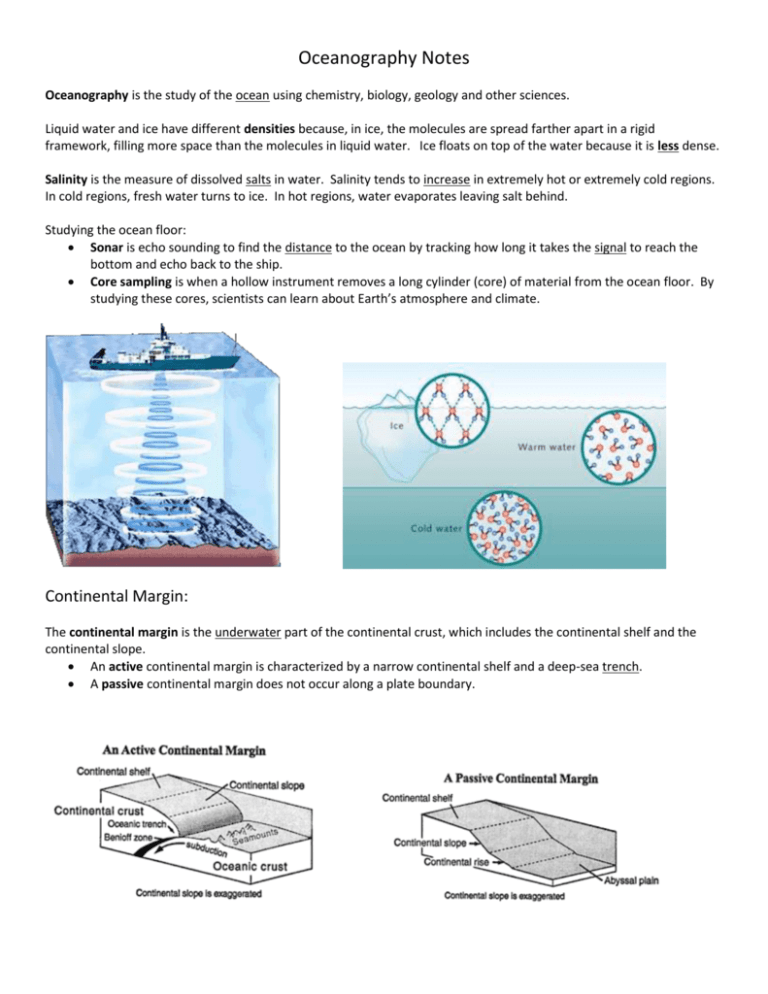
Oceanography Notes Oceanography is the study of the ocean using chemistry, biology, geology and other sciences. Liquid water and ice have different densities because, in ice, the molecules are spread farther apart in a rigid framework, filling more space than the molecules in liquid water. Ice floats on top of the water because it is less dense. Salinity is the measure of dissolved salts in water. Salinity tends to increase in extremely hot or extremely cold regions. In cold regions, fresh water turns to ice. In hot regions, water evaporates leaving salt behind. Studying the ocean floor: Sonar is echo sounding to find the distance to the ocean by tracking how long it takes the signal to reach the bottom and echo back to the ship. Core sampling is when a hollow instrument removes a long cylinder (core) of material from the ocean floor. By studying these cores, scientists can learn about Earth’s atmosphere and climate. Continental Margin: The continental margin is the underwater part of the continental crust, which includes the continental shelf and the continental slope. An active continental margin is characterized by a narrow continental shelf and a deep-sea trench. A passive continental margin does not occur along a plate boundary. Ocean Floor Features Ocean currents – A surface current generally flows in the upper 1000 meters of the ocean and are primarily driven by wind. Warm currents tend to flow away from the equator. Cold currents tend to flow toward the equator. Currents in the Northern hemisphere flow in a clockwise direction. Currents in the Southern hemisphere flow in a counterclockwise direction. The Gulf Stream is a narrow intense flow of warm water that begins in the Caribbean Sea and follows the east Coast of the United States northward. Deep ocean currents are driven by differences in density. The density of ocean water is affected by temperature and salinity. o Cold water is denser than warm water o Water with a high salinity is denser than water with a low salinity. The global circulation of ocean currents is often modeled as a Global Conveyor Belt. Circulating currents transport warm water to colder areas and cold water to warmer areas. A density current is a subsurface current that is heavier or more dense than the surrounding water. Density currents move very slowly compared to surface currents and circulates toward the bottom for 500-2000 years. They retain the oxygen absorbed at the surface layer and are the only source of oxygen for deep-sea life. The densest water in the oceans comes from polar regions, due to cooling causing molecules to contract. As seawater evaporates, the salt in the water is left behind, which increases salinity and density. An example of a density current formed by evaporation is found in the Mediterranean Sea. Upwelling is a kind of vertical current in the ocean and occurs when cold deep water comes to the surface. Upwelled water contains large amounts of nutrients that phytoplankton need in order to grow. Phytoplankton are microscopic organisms that are the basic food for other living things in the ocean. Upwelling occurs when surface water is displaced by winds or density currents. The cold deep water rises to replace the surface water. The thermocline is the layer of the ocean, just beneath the surface region, where the temperature drops rapidly. El Nino refers to a long term disturbance in the ocean temperature and atmosphere over the Pacific Ocean. It is characterized by warm surface waters in the Pacific Ocean off the Western coast of South America. El Nino is caused by weaker than normal trade winds over the Pacific, which weakens sea surface currents, and allows the buildup of warm water in the eastern Pacific. Typical effects include o Warmer than average temperatures over Western and Northern US. o Wetter than average conditions likely over U.S. Gulf Coast and Florida o Drier than average conditions in the Ohio Valley and the Pacific Northwest La Nina is characterized by: Below-average sea surface temperatures off the Western Coast of South America Pacific trade winds blow more strongly than usual, pushing the sun-warmed surface water farther west and increasing the upwelling of cold water in the Eastern regions. Winter temperatures are warmer than normal in the Southeast and cooler in the Northwest Conditions occur every few years and can last as long as 2 years. Typical El Nino – December –February Typical El Nino – June-August Typical La Nina – December-February Typical La Nina – June-August
